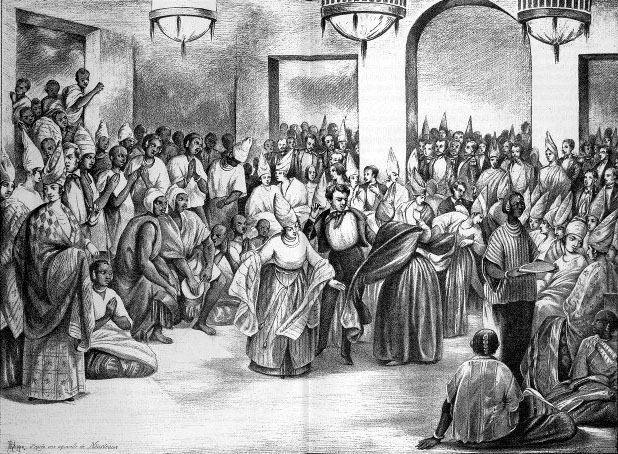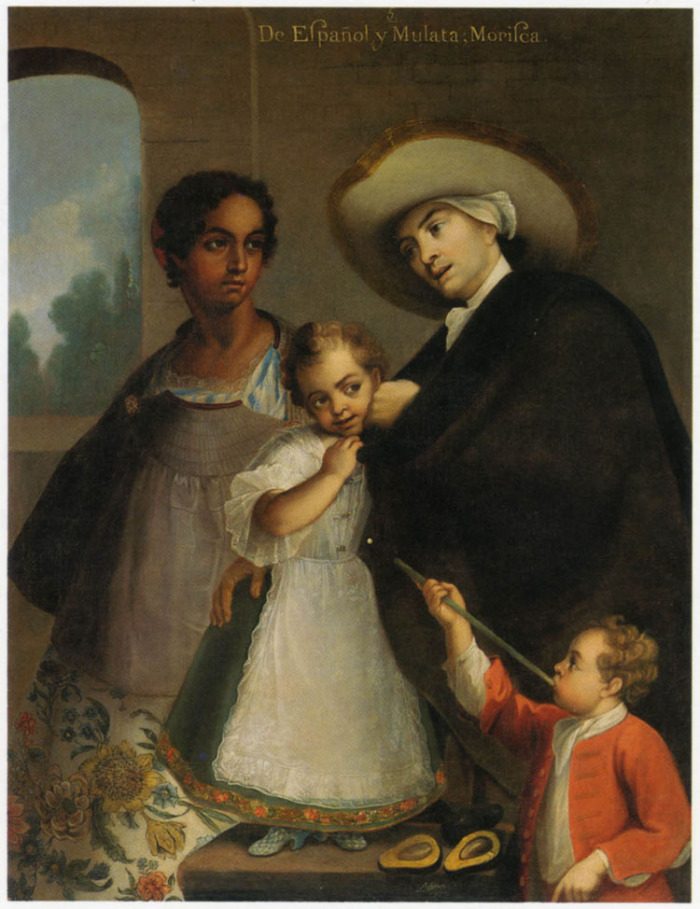|
Henriette DeLille
Henriette Díaz DeLille, SSF (March 11, 1813 – November 17, 1862) was a Louisiana Creole of color and Catholic religious sister from New Orleans. She founded the Sisters of the Holy Family in 1836 and served as their first Mother Superior. The sisters are the second-oldest surviving congregation of African-American religious. In 1988, the congregation formally opened the beatification process for DeLille with the Holy See. She was of mixed race: her father was a white man from France, her mother was a quadroon, and her maternal grandfather was a white man from Spain. Biography Early life Henriette DeLille was born in New Orleans, Louisiana, on March 11, 1813. Her mother, Marie-Josèphe "Pouponne" Díaz, was a free woman of color of New Orleans. Her father Jean-Baptiste Lille Sarpy (''var.'' de Lille) was born about 1758 in Fumel, Lot-et-Garonne, France. Their union was a common-law marriage typical of the contemporary plaçage system. She had a brother, Jean DeLille, an ... [...More Info...] [...Related Items...] OR: [Wikipedia] [Google] [Baidu] |
Venerable
''The Venerable'' often shortened to Venerable is a style, title, or epithet used in some Christianity, Christian churches. The title is often accorded to holy persons for their spiritual perfection and wisdom. Catholic In the Catholic Church, after a deceased Catholic has been declared a servant of God by a Bishop (Catholic Church), bishop and proposed for beatification by the pope, such a servant of God may next be declared venerable ("heroic virtue, heroic in virtue") during the investigation and process leading to possible canonization as a saint. A declaration that a person is venerable is not a pronouncement of their presence in Heaven. The pronouncement means it is considered likely that they are in heaven, but it is possible the person could still be in purgatory. Before one is considered venerable, one must be declared by a proclamation, approved by the pope, to have lived a life that was "heroic in virtue" (the theological virtues of faith, hope, and charity and the ... [...More Info...] [...Related Items...] OR: [Wikipedia] [Google] [Baidu] |
Plaçage
Plaçage was a recognized extralegal system in French slave colonies of North America (including the Caribbean) by which ethnic European men entered into civil unions with non-Europeans of African, Native American and mixed-race descent. The term comes from the French meaning "to place with". The women were not legally recognized as wives but were known as ''placées''; their relationships were recognized among the free people of color as ''mariages de la main gauche'' or left-handed marriages. They became institutionalized with contracts or negotiations that settled property on the woman and her children and, in some cases, gave them freedom if they were enslaved. The system flourished throughout the French period, reaching its zenith during the latter, between 1769 and 1803. The system may have been most widely practiced in New Orleans, where planter society had created enough wealth to support the system. It also took place in the Latin-influenced cities of Natchez and Bilo ... [...More Info...] [...Related Items...] OR: [Wikipedia] [Google] [Baidu] |
Mary Elizabeth Lange
Mary Elizabeth Lange, OSP (born Elizabeth Clarisse Lange; – February 3, 1882) was an American religious sister in Baltimore, Maryland who founded the Oblate Sisters of Providence in 1829, the first African-American religious congregation in the United States. She was also, via the Oblates, the first African-American superior general. The cause for her beatification was opened in 1991. Pope Francis named her as venerable on June 22, 2023. Life Early life Lange was born in Saint-Domingue about 1789. It is said that her mother, Annette Lange, was the daughter of a Jewish plantation owner and an enslaved African woman. Her father, Clovis, was said to be an enslaved mulatto man on the same plantation. During the Haitian Revolution, her parents escaped and took the family to Cuba, settling in Santiago de Cuba. There Lange received an excellent education. She left Cuba in the early 1800s and immigrated to the United States. According to oral tradition of the Oblate Sisters of Pr ... [...More Info...] [...Related Items...] OR: [Wikipedia] [Google] [Baidu] |
Superior General (Christianity)
A superior general or general superior is the leader or head of an 'order' of religious persons (nuns, priests, friars, etc) or, in other words, of a 'religious institute' in the Catholic Church, and in some other Christian denominations. The superior general usually holds supreme 'executive' authority in the religious community, subject only to the Pope in the case of Catholic orders, while the general chapter has 'legislative' authority. Many Catholic superiors general are elected (directly or indirectly) by their order's membership, and are based in Rome, and thus facilitate their order's engagement with other elements of church leadership (the Pope; the Roman Curia; other orders' leadership). History The figure of superior general first emerged in the thirteenth century with the development of the centralized government of the Mendicant Orders. The Friars Minor (Franciscans) organized their members under a Minister General (Franciscan), Minister General, and the Order of Preac ... [...More Info...] [...Related Items...] OR: [Wikipedia] [Google] [Baidu] |
Antoine Blanc
Antoine Blanc (11 October 1792 – 20 June 1860) was the fifth Bishop and first Archbishop of the Roman Catholic Archdiocese of New Orleans. His tenure, during which the diocese was elevated to an archdiocese, was at a time of growth in the city, which he matched with the most rapid church expansion in the history of New Orleans. More new parishes were established in New Orleans under his episcopacy than at any other time. Early life and education Antoine Blanc was born in Sury, near Sury-le-Comtal, then in the Department of Rhône-et-Loire, France. He attended the seminary at Sury-le-Comtal and was ordained in 1816. On 1 July 1817 he embarked from Bordeaux with Louis William Valentine Dubourg Bishop of the Diocese of Louisiana and the Two Floridas, who had traveled to Europe to recruit clergy. They arrived in Annapolis, Maryland in September. Blanc and a number of seminarians stayed with Charles Carroll of Carrollton until the end of October when they joined Dubourg in Balti ... [...More Info...] [...Related Items...] OR: [Wikipedia] [Google] [Baidu] |
Religious Habit
A religious habit is a distinctive set of clothing worn by members of a religious order. Traditionally, some plain garb recognizable as a religious habit has also been worn by those leading the religious Hermit, eremitic and Anchorite, anchoritic life, although in their case without conformity to a particular uniform style. Uniformity and distinctiveness by order often evolved and changed over time. Interpretation of terms for clothes in religious rules could change over centuries. Furthermore, every time new communities gained importance in a cultural area the need for visual separation increased for new as well as old communities. Thus, modern habits are rooted in historic forms, but do not necessarily resemble them in cut, color, material, detail or use. In Christian monasticism, Christian monastic orders of the Catholic church, Catholic, Lutheranism, Lutheran and Anglicanism, Anglican Churches, the habit often consists of a tunic covered by a scapular and cowl, with a hood ... [...More Info...] [...Related Items...] OR: [Wikipedia] [Google] [Baidu] |
Iberia Parish, Louisiana
Iberia Parish (, ) is a Parish (administrative division), parish located in the U.S. state of Louisiana. At the 2020 United States census, 2020 census, it had a population of 69,929; the parish seat is New Iberia, Louisiana, New Iberia. The parish was formed in 1868 during the Reconstruction era (United States), Reconstruction era and named for Iberian Peninsula, Iberia. It is part of the 22-parish Acadiana region of the state, with a large Francophones, Francophone population. Some of its ethnic French residents had ancestors who settled here after being expelled in the 18th century by the British from Acadia in present-day Canada. Historically, it has also been a center for sugar cane cultivation and produces the most sugar of any parish in the state. Iberia Parish is part of the Lafayette metropolitan area, Louisiana, Lafayette metropolitan area. The Port of Iberia has a waterway with access to the Gulf Coast. History Iberia Parish was created from parts of St. Martin Paris ... [...More Info...] [...Related Items...] OR: [Wikipedia] [Google] [Baidu] |
Quadroon
In the colonial societies of the Americas and Australia, a quadroon or quarteron (in the United Kingdom, the term quarter-caste is used) was a person with one-quarter African/ Aboriginal and three-quarters European ancestry. Similar classifications were octoroon for one-eighth black (Latin root ''octo-'', means "eight") and quintroon for one-sixteenth black. Governments of the time sometimes incorporated the terms in law, defining rights and restrictions. The use of such terminology is a characteristic of hypodescent, which is the practice within a society of assigning children of mixed unions to the ethnic group which the dominant group perceives as being subordinate. The racial designations refer specifically to the number of full-blooded African ancestors or equivalent, emphasizing the quantitative least, with quadroon signifying that a person has one-quarter black ancestry. Etymology The word ''quadroon'' was borrowed from the French ''quarteron'' and the Spanish ''cuarte ... [...More Info...] [...Related Items...] OR: [Wikipedia] [Google] [Baidu] |
Passing (racial Identity)
In the United States of America, racial passing occurred when a person who was categorized as Black in regard to their race in the United States of America, sought to be accepted or perceived (" to pass") as a member of another racial group, usually White. Historically, the term has been used primarily in the United States to describe a black person, especially a Mulatto person who assimilated into the white majority to escape the legal and social conventions of racial segregation and discrimination. In the Antebellum South, passing as White was a temporary disguise used as a means of escaping slavery. United States Passing for white Although anti-miscegenation laws outlawing racial intermarriage existed in the North American Colonies as early as 1664, there were no laws preventing or prosecuting the rape of enslaved girls and women. Rape of slaves was legal and encouraged during slavery to increase the slave population. For generations, enslaved black mothers bore mixed ... [...More Info...] [...Related Items...] OR: [Wikipedia] [Google] [Baidu] |
Louisiana Creole People
Louisiana Creoles (, , ) are a Louisiana French people, Louisiana French ethnic group descended from the inhabitants of colonial Louisiana (New France), Louisiana during the periods of French colonial empire, French and Spanish Empire, Spanish rule, before it became a part of the United States. They share cultural ties such as the traditional use of the Louisiana French language, French, Spanish language, Spanish, and Louisiana Creole, Creole languages, and predominantly practice Catholic Church, Catholicism. The term ''Créole'' was originally used by Louisiana French people, French Creoles to distinguish people born in Louisiana from those born elsewhere, thus drawing a distinction between Old-World Europeans (and Africans) and their descendants born in the New World.Kathe ManaganThe Term "Creole" in Louisiana : An Introduction, lameca.org. Retrieved December 5, 2013 [...More Info...] [...Related Items...] OR: [Wikipedia] [Google] [Baidu] |
Cyprian Davis
Cyprian Davis, O.S.B., D.Hist.Sci. (born Clarence John Davis; September 9, 1930 – May 18, 2015) was an African-American Catholic monk, priest, and historian at St. Meinrad Archabbey in Indiana. He is known for his work on the history of Black Catholicism. Biography Davis was born in Washington, D.C., on September 9, 1930. He converted to Catholicism in his teenage years and became interested in joining the priesthood as well as becoming a monk. Though many monastic communities (and most Catholic religious institutes) did not accept African Americans at the time, after high school Davis joined the seminary of St. Meinrad Archabbey (1949–1956). He became a novice on July 31, 1950, took the monastic name Cyprian on August 1, 1951, and was ordained a priest on May 3, 1956. He was the first African American to join that monastic community. Davis received a Licentiate of Sacred Theology from the Catholic University of America (1957), before going to the Catholic University of L ... [...More Info...] [...Related Items...] OR: [Wikipedia] [Google] [Baidu] |


